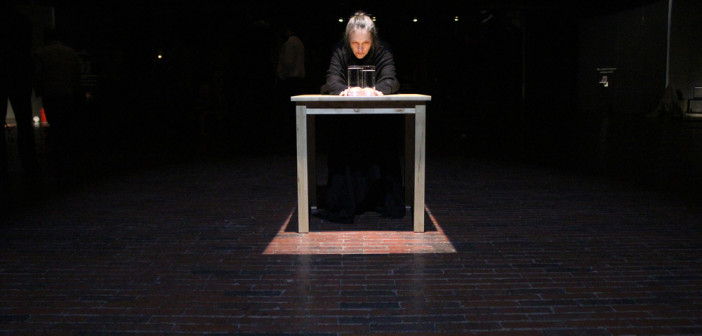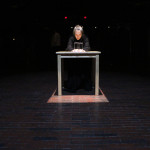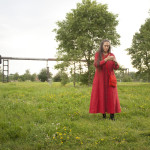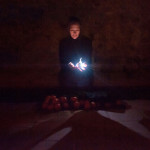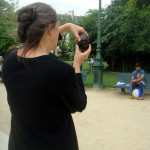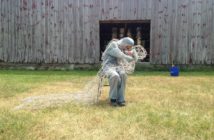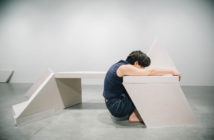Liz Munsell One thing I’ve noticed working with you so far—which I must say has been nothing but an honor and a pleasure—has been how easy you make the job of a curator, precisely because you consider the context in which your work unfolds. I’m wondering if this concern is specific to your artistic practice as a performance artist, or something you consider part of the visual language of performance art in general?
Marilyn Arsem I guess I think of it as my own practice. I have to allow other people to make their work differently and still call it performance art, but it does have to do with me being interested in making work that responds to a location, and making work that’s really a kind of conversation or a way to consider questions that I have about a place and the ideas that the place brings up. I try not to feel obligated to provide answers, which is sometimes an expectation. Some artists want to tell you not only what they think, but often want to tell you what they think you should be thinking. I’m much more interested in creating an action which allows an audience to consider with me the questions that I have. So I’m trying to design it in a way that they end up having to consider the place with me, at the same time, and hopefully in similar ways as I am.
I want to make work that doesn’t leave a mark. I try to be careful in my use of resources and I try not to waste materials. I want to have a low environmental impact. It occurs to me that this aspect might be the result of cleaning up other people’s performances, when I was director of Mobius. I still want to have a high impact, but just on the psyche!
When you say that I work like a curator, I would say that probably some aspect of considering the location and the audience is also related to having run a space.
One of the reasons I began to work this way, and stopped bringing a prepared piece was because—and it happened once I started traveling more—I wanted to honor the place where I was, rather than trying to make it conform to where I came from. It made me really pay attention and experience where I was more fully. I had to go out and talk to people. I’m shy, and I’m not so comfortable just chatting with people, but if I’m obligated to make a work then I have to actually go out and talk to people and smell the place and touch it and see what’s in the market, ask questions about their lives, what they do, what they eat, what they are thinking about: I want to work with what’s there so I have to really spend time becoming familiar with the place. The other aspect, which comes from talking with my hosts or other local artists, is to learn what’s in the air in terms of issues or states of mind, or concerns, because those are things that I want to take into consideration in the work. I always worry about offending people. I don’t want to be considered an arrogant American, which can easily happen, given our reputation in the world. I don’t always know how they will read the work and so I want to have it be more open and more conversational, so that I’m not making a judgment but simply asking questions. That way if I stray into territory that they understand differently it actually allows for a deeper conversation.
LM It’s like giving over some responsibility for the work to your public—which is a possible definition of social practice or participatory art—but you’re not often asking the viewer to do a specific action, like the more mechanical obligations characteristic of "interactive art." Whatever it is that’s required of the audience is much more open.
MA Well I’ve done plenty of performances where the audience participated in the action, but I have done fewer of them since I began working in countries where English is not the first language. I began to work much more imagisticly and without relying on language. Though I have often made use of people who knew both languages and structured it so that the information got passed along, person to person. That’s something you have to take into account.
LM You have performed all over the world yet you don’t often make work in Boston. Knowing this city so well, how has the process for making work for Odd Spaces at the MFA been different for you?
MA It’s actually harder to work in a city with which I am really familiar, because I don’t see it anymore. I don’t pay attention in the same way. Things don’t seem odd because I am already used to them.
LM It doesn’t elicit the kind of response that an unfamiliar place might?
MA I did approach it similarly, where I took a walk through the Museum without any plan about where to go, and just paid attention to what seemed like odd spaces. It was very useful to have the title as a guide. I tried to lose what I knew about the place and just pay attention to what kinds of spaces existed in it.
LM In a way you are considering the context of the exhibition rather than just the context of the site or the country and it’s practices—and I know you don’t want to reveal too much about what we’re going to see on the fifteenth—but I wanted to point out that in your work in general, the aesthetic decisions you make are often intuitive, and later on, post-performance, a meaning or association evolves. This particular work seems more direct in its approach, perhaps because there is a curator involved asking you to mine for meaning from the beginning?
MA I knew you’d wonder why I chose those particular galleries so I did think about it! Most of the time I have the luxury of not having to actually articulate why I’m choosing to do what I’m doing. There’s always a meaning, but I also feel comfortable enough at this stage of my art-making to trust my instincts. I feel comfortable enough to experiment. I feel willing to fail, more willing than I probably did when I was younger . . . What I am willing to do now is trust that if I have an impulse to do something that I can construct an action that will carry meaning. And, I trust that I had the impulse to do it because it was meaningful to me; even if I can’t fully articulate in advance why it is, what it is. But the process of preparing for the work allows me to consider choices. You know some of the ones I was fiddling with and the ones I’ve rejected. It’s a process of throwing the net broadly and then tossing out what doesn’t feel quite right. It is the process of really stripping it down to something that is as minimal as possible, in that it has only as many elements as I think are needed to communicate the idea. I still make those choices by intuition. It’s what feels right. It’s imagining myself in this situation and also imagining myself as the audience. Often right before I fall asleep at night, I imagine the performance, but I do a kind of astral projection where I am floating above the performance watching myself. It becomes the perspective of the audience but what I understand from that visualization is the kind of energy or mood that is driving the work. It helps me to understand why I want to do it. My works are images before I completely embody them, and long before I can fully articulate them.
LM It’s really interesting that you say that its not typically required of you to articulate the meaning. This has to do with issues of spectatorship in the museum context, where there is an expectation that the visitor will gain an understanding that’s validated by experts. Explanatory wall texts are an example, because they shape the experience of reading an artwork. Is that problematic for you as an artist who has worked in so many different contexts where that wasn’t required of you?
MA When I have had the luxury of not having to articulate it until afterwards, I have also had the luxury of being asked to perform but not having to say in advance what I’m going to do. There are a lot of contexts where I haven’t shown work because I don’t write proposals. In the countries where I normally perform, the audience and organizers are much more interested in the process and experience of performance and art. In the U.S. we’re much more oriented to buying a product or looking at art as an investment object. In the U.S. performance is placed in this territory of commerce, and it can be difficult for audiences to assign value to an experience. It is equally hard for an artist to take a risk and create a new performance in that context. As a performance artist, I create the work for the first time while being witnessed by the viewers. The best audience for performance is one that understands that they are seeing a human being trying something for the first time, and thinking through problems as they confront them in the task of making the work. They don’t witness that part of the process with a painter. The painter does that in private in the studio.
LM It’s a more outcome-oriented, rather than a process-oriented audience. What am I getting out of this? What can I buy from this?
MA In this context I knew you were going to ask me what the work would be, and so I thought about it and I also felt comfortable enough with you that I could talk through my idea and test some of the related ones. I trusted you to be able to move through the thinking with me, about what I might do, rejecting some elements, and allowing me to talk through the preliminary ideas without worrying that I wasn’t going to come up with something at the end. I guess the only other thing I’ll say is that intuition is driven by ideas also. It is the articulation in words that comes later, not the actual manifestation.
LM This is your first performance at the Museum of Fine Arts. What do you expect from the Museum’s audience and the museum context? How is this different or similar to your past audiences? And, how does the audience dynamic change when you are talking about a place that’s chock full of objects vs. a performance festival where it’s mostly body-to-body?
MA When I was walking through the galleries that day, I was looking at objects and thinking about the experience of being considered an object. I was looking at spaces that were odd, but I was also thinking about the viewer walking through the galleries and looking at objects. What happens when an object is alive?
Some of those same concepts are embedded in what Sandrine and Philip are doing too. And the way you negotiate other bodies in museums, other viewers, or also the way you believe there are certain things you shouldn’t be looking at. I hadn’t looked at the odd spaces in the Museum before you told me your title. You look at things. You don’t look between things.
LM Exactly, and you don’t think about the processes that make those things possible— someone is making sure that there is not a piece of trash in front of an object, or that you have something to eat that someone in a museum kitchen cooked, and go to the bathroom that someone cleans—in between looking at the things your eyes are supposed to fall on.
Is there anything you want to say about your process in the Museum’s collections in relation to this piece? Not to put you on the spot!
MA Well I’ll just say that I am interested in human bodies in the Museum.What is so different about this context, of the MFA, is in fact that people are there to look at objects. I know that you and I have had a lot of discussion about how to say something—but not too much—about what I’m doing because it really is a kind of hidden performance. For that reason, I don’t know what else I can say about it. I think for a lot of people they will imagine the performance after the fact.
LM They might not find it.
MA But it will operate in the same fashion, regardless. They will imagine themselves there.
LM How long have you been working as faculty at the School of the Museum of Fine Arts? Can you tell us a bit about the performance art program and how it has evolved over the years?
MA I’ve been teaching performance art at SMFA since 1987. But performance art classes have been taught at the school since the sixties. There wasn’t a performance area, or department, so depending on different faculty’s interests, performance classes would appear under the auspices of different media areas. Early on, Larry Johnson taught classes that involved text and slide shows, and Richard Lerman taught sound art and general performance art classes. There was work that also was secretly done at the Museum in the sixties, before I was ever there. It was much more along the lines of conceptual and Fluxus work. So there was a history of it when I started at the school. Initially I was filling in for Richard Lerman because he had gotten a Guggenheim award. Then, when he came back he arranged for me to continue teaching performance. Based on student interest we gradually expanded the offerings in performance.
What is true was that early on I made a decision to teach visually based performance that had a relationship to installation and sculpture. Obviously it’s a visual arts program at the Museum School, but it was during the era in the US when much of what was called performance art were scripted and rehearsed monologues. We made an active decision to work with actions and materials, and not to teach the writing of theatrical monologues. So we made a very clear choice to focus on the kinds of performance art that were more common in the rest of the world. For a long time the art history classes didn’t cover performance art so we very early on included history and theory as part of our classes. And, we also began to recognize that performance-based practices inform other media and that we could talk about performativity or how to use performance as a method to develop ideas. The embodied nature of performance allows students to experiment with an idea—even though the work might end up in another media—but performance was a way to work on the ideas directly and get immediate feedback from witnesses, which is really useful. In our classes, the rest of the students serve as a critique group. They often help each other to make the work, and document it for each other. It’s much more of a collaborative context, which is different from the mode of being a painter alone in the studio. So what it also means is that the students who are interested in operating in a community are often attracted to the performance area.
So much performance art dropped from visibility in the US art scene with the defunding of the NEA Four and overall reduction of grants in the early 90s. A lot of venues were afraid to program performance because they were worried their funding would be cut. Performance art went underground. At the school we began to bring in international artists to work with our students and also to take our students to international festivals, including Quebec, Canada, Indonesia, France, Chile, Sweden, and Belarus. We’re trying to introduce our students to the broader context of art that exists beyond the United States. Our course offerings in performance art have gradually expanded over the years. Mari Novotny-Jones has been teaching part-time in the area since the nineties, and seven years ago we had an international faculty search, and as a result brought in Tony Schwensen, from Australia, to teach full-time in performance. We now have one of the largest programs in visually-based performance art nationally as well as internationally.
LM Knowing the context of the Museum so well, having worked next door, what do you expect from the audiences that come here?
MA I’d have to say that it’s really been thrilling to have the Museum open the Contemporary wing and actually be interested in performance, because that is not consistent with the past. We were doing a kind of work that was for the most part being ignored by the MFA. So it’s really wonderful to have this change happening in my lifetime. That was not something I expected. So thank you!
Particularly in the eighties there were a lot of performance artists in the US, but when the cuts happened at the NEA, and performance artists were demonized, many of them stopped making work. My choice was to go elsewhere and continue making it. Not everyone had that possibility, but in many instances they started making work that was in the form of installation or video. There is a kind of gap in American performance history because of that.
LM But not here in Boston thanks to you!
MA But we still have tended to operate more in the underground and certainly we don’t have the financial support that big art institutions have. We’ve never had that. It is one of the reasons that Mobius has remained small.
LM How might your piece, or performance art in general, change the MFA public’s definitions of or relationship to art?
MA I hope that people would consider an experience as art rather than just thinking that it has to be an object to be art. And so whether they see me, or imagine contemplating eternity with me, either action is the artwork.
- Edge Durational performance by Marilyn Arsem Near Death Performance Art Experience Cyclorama, Boston, MA April 2013 Photo by Phil Fryer
- I Have to Leave Durational performance by Marilyn Arsem Blow! 8 International Performance Art Festival Ilsede, Germany June 2012 Photo by Insa Wagner
- Marking Time a durational performance by Marilyn Arsem Nox Contemporary, Salt Lake City, Utah November, 2012 Photo by Kristina Lenzi
- earth and oranges Durational performance by Marilyn Arsem Fem_12 International Festival of Performance Girona, Spain December 2012 Photo by Ana Rita Rodrigues
- Universe I durational performance by Marilyn Arsem Live Action Sweden #7 Mariestad, Sweden May 2012 Photo by Joakim Stampe
- Universe II durational performance by Marilyn Arsem Infr’Action Paris, Festival International d’Arte Performance Square du Temple, Paris, France May 2012 Photo by Evelyne Goupy
This interview was conducted in light of the upcoming performance art event at the MFA Boston, Odd Spaces, and the panel discussion that will follow.
More information on mfa.org

